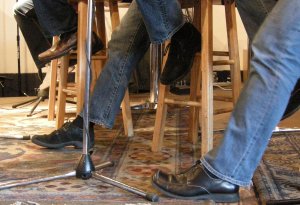 Waiting for investors can mean trouble for startups, especially in Portland’s capital-starved market. Four successful entrepreneurs spoke at OEN’s PubTalk last Wednesday about the pros and cons of bootstrapping, and the benefits of taking orders from your customers instead of an investor.
Waiting for investors can mean trouble for startups, especially in Portland’s capital-starved market. Four successful entrepreneurs spoke at OEN’s PubTalk last Wednesday about the pros and cons of bootstrapping, and the benefits of taking orders from your customers instead of an investor.
BY ANGELA WEBBER
|
BY THEIR BOOTSTRAPS: Entrepreneurs spoke at OEN’s PubTalk last week on the possibilities of bootstrapping. |
The crowd at Oregon Entrepreneurs Network‘s monthly PubTalk Wednesday consisted of three main types of folks: entrepreneurs desperate to pitch their start-ups, lawyers eager to get new clients, and MBA students learning how to network. They all had something to learn when the hors d’oeuvres were put away and the panel took the stage for “The Art of Bootstrapping.”
The main lesson of the night: your customer is your number one investor. The order of business building: idea, business model, investor, product, customer–is all wrong, said the panel. Each of the four presenting entrepreneurs started with an idea, but soon learned that it is the customer who should determine the direction of the project.
Jama founder Eric Winquist said he had always thought entrepreneurs who dig into their own pockets and credit card bills to fund their companies were crazy. But when he went days, weeks, and months without an investor, he found himself doing the same thing.
All of the panelists had a similar story; they hadn’t planned to bootstrap from the start, but it became a necessity. Now they say this is a great way to go.
“I don’t see why you should build something you haven’t already sold,” said Paul Anthony, who started his company, Rumblefish, with $400 of his own money in his college dorm room.
“Find a customer and then back in to everything else,” said Eli Alford-Jones of Paydici, a Portland-based online rent paying service.
|
CATCH-22: Jama founder Eric Winquist says that once you can convince an investor to give you money, you probably don’t need it. |
Investment is hard to find, particularly in Portland. Though there are some organizations, like the Oregon Angel Fund, that invest in young businesses, starting a project is difficult. Winquist described it as a catch-22: “No one wants to invest in you until you have a proven business model, but once you have one, you don’t need funding.”
The easiest way to bootstrap is to design a product you can build yourself. But if you can’t build it yourself, you need to find someone with that technical expertise that’s willing to work for promise of pay. “That’s how you get co-founders,” said Winquist.
The entrepreneurs said that the problem of ownership and control always comes up when investors are brought into the picture. When you finance a business yourself this problem is somewhat mitigated, but it also appears from the other end: the customer. Rumblefish, said Anthony, was a company that changed direction and product drastically depending on what the customer wanted. “Compromise to your client’s needs,” he said, “but make sure the product is something your team is passionate about.”
Eric Doebele of Reliable Remodeler added that it’s important not to get too attached to your own idea. “It’s better not to have a perfect product, because it probably won’t be the right thing at the end of the day.”



